|
The Chapel of Hathor - Speos |
update:
03.01.2012
|
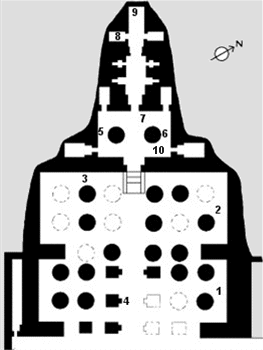
| Above the floor plan of the Chapel of Hathor with the
location of various scenes.
|
| 1 |
Hathor-Cow inside a shrine;
opposite wall:
Hathor-Cow in a shrine is suckling and
protecting the royal child |
| 2 |
Procession of Hathor with barques and soldiers; in the
northwestern corner Thutmosis III is shown with an oar before Hathor |
| 3 |
from left to right, left (south) of the entrance:
ritual run with bird before Hathor,
Hathor-Cow licking the hands of the queen;
right (north) of the entrance:
Hathor-Cow licking the hands of the queen,
ritual run "Seizing the Oar".
|
| 4 |
Pillars with Hathor-standards, columns with Hathor-heads |
| 5 |
Weret-Hekau offering a menat to Amun |
| 6 |
Hatshepsut before Hathor |
| 7 |
Royal titles on lintel and jambs, on both sides two Hathor-standards
(see photo below) |
| 8 |
Portraits of Senenmut |
| 9 |
Hatshepsut (replaced by Thutmosis III) embraced by Hathor,
both before Amun |
| 10 |
Hatshepsut (replaced by Thutmosis III) playing ball before Hathor |
|
|
According to Wysocki (1992) the purpose of the small room south of the
Chapel of Hathor is not known. |
| The entrance to the chapel leads to an Ante-room supported by
two 16-sided (proto-doric) columns. Since the entrance to the chapel is closed for the public, the
two columns block the view from the entrance into the Ante-chamber so that
nearly nothing of the decoration can be seen. Only the doorways of the passage
to the sanctuary can be looked at without obstruction.
|
| In each corner of the room (not visible from
the entrance) is a deep niche, the two is on the west side goes westward into the
wall, on the eastern side of the room one goes to the north and on to the south.
Since all niches contain on the rear-wall a figure of the queen Naville assumed that all four niches were intended for statues of the queen.
According to Naville all paintings have been more or less touched. He believed
that the most original work can be seen in the southern niche. There Thutmosis
III is depicted worshipping Hathor, and right of this scene Hatshepsut (erased)
is shown before a seated Amun. |
| The following two photos the Great Ennead above the southern niche.
|
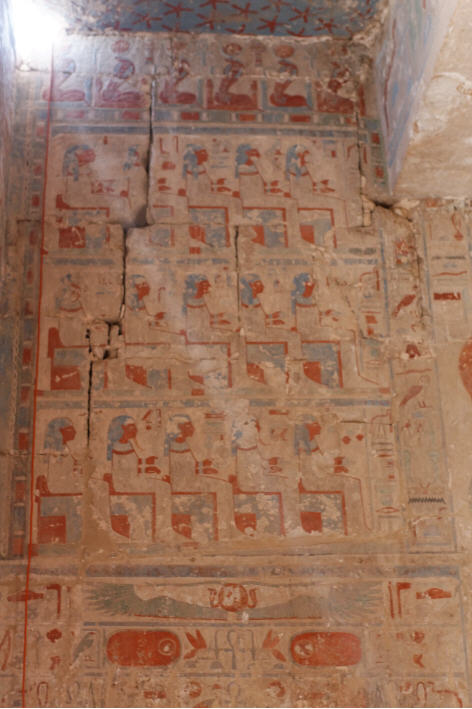
| The following two photos show what is visible from the scene on
the south wall of the Ante-room (left) and on the north wall (right).
|
|
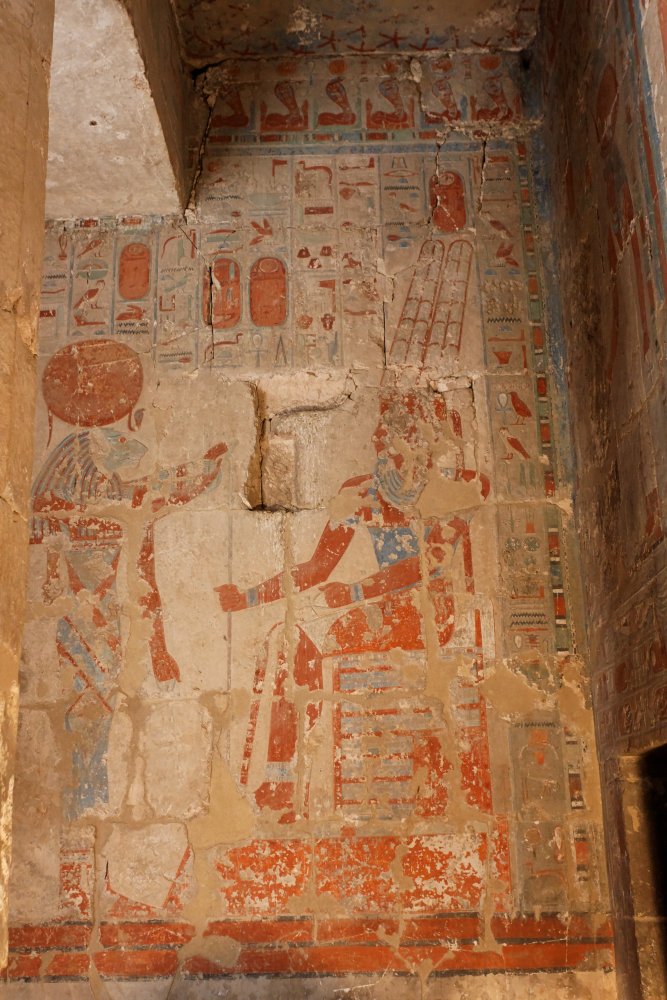
|
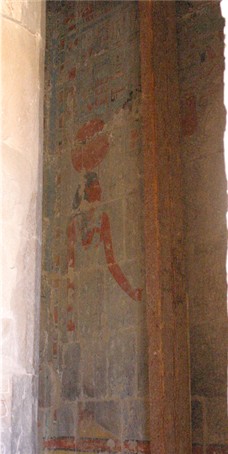
|
| Hatshepsut (her figure between the gods has been erased)
is crowned by Weret-Hekau and Amun (position 5) |
Hatshepsut (figure destroyed) offering a vase to Hathor (position 6) |
| On the inner northeast wall of the Ante-chamber we have a rare
representation, whose symbolic meaning is uncertain, the "Hitting the Ball".
This scene has been represented abundantly between the 18. Dynasty and Ptolemaic
times. Borghouts (1973) mentioned 19 locations whereby the representation in the Chapel of Hathor, Hitting the ball in
honor of Hathor, protectress of Thebes", is the oldest one known. |
| The queen (cartouche has been changed to Men-kheper-ka-Ra,
Thutmosis III.) stands before Hathor. In her left hand she is holding a
ball, in her right a wavy staff. The inscription does not explain the meaning of
the rite. |
| However, the ritual aspect is stressed in this scene by two priests standing between king and goddess,
catching balls or handing them to the king. In later representations, e.g. in the
Luxor temple (Porter& Moss, II, Room XIII, p. 327; Room II, p. 319) these priests are
missing and the king uses a straight stick. |
| According to Borghouts (loc. cit.) the ball may be interpreted as the eye of Apophis. The
ritual shown may go back to the fight between the eye of Ra and the eye of his
enemy, Apophis, which is supported by the fact that the ritual was performed
only before goddesses
(for example see Luxor-Temple, "Hitting the ball" before Hathor in room XIII,
and before Mut in room II) who are identified as the eye of Ra. |
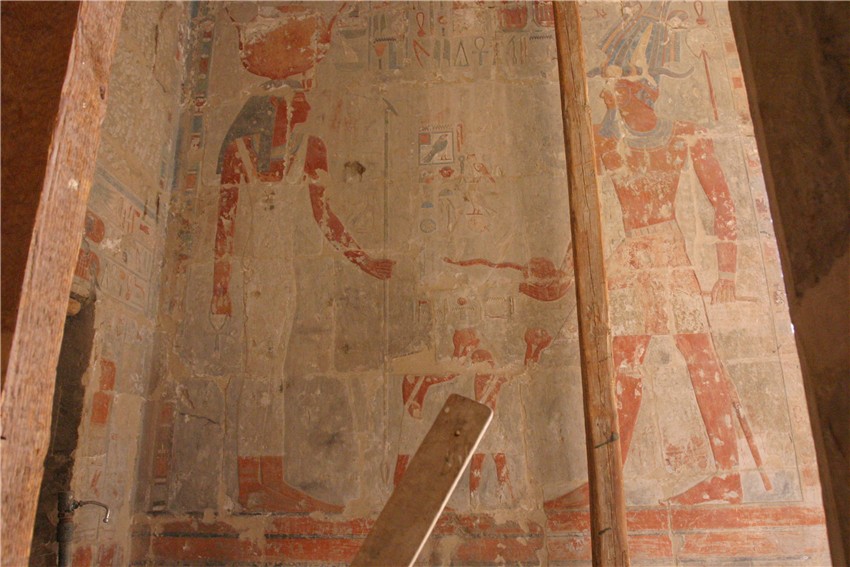
| Hatshepsut "Hitting the ball" before
Hathor (position 10). |
| On the inner southeast wall of the Ante-chamber Hatshepsut (erased)
is depicted consecrating four Meret-chests before Hathor (next photo).
|
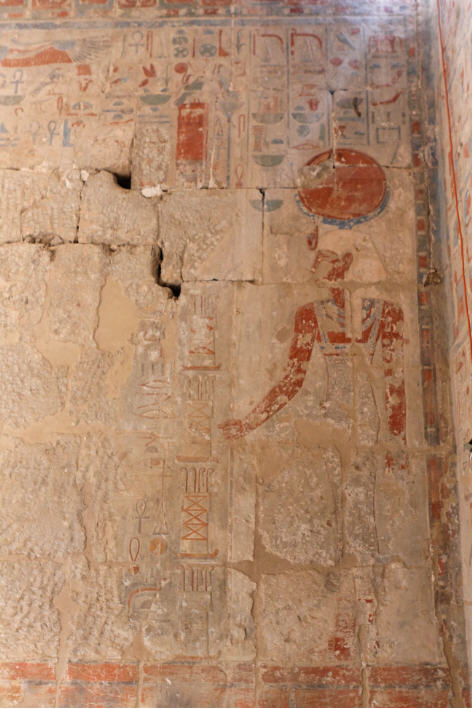
| The decoration of the first entrance to the passage which leads
to the sanctuary is quite peculiar. The painted decoration
shows a arched roof supported by (proto-doric) columns with Hathor-capitals.
Most extraordinary are two dots somewhat below capitals, which, according to
Naville, must be
considered as two eyes. Directly next to these points a single horn branches off
on the side opposite to the passage on each pillar - on the other side of the pillar(s) there is no horn. |
| The horizontal lines above the doorway show on the left names
and titles of Thutmosis II, and those of Thutmosis III on the right. |
| The vertical at both sides of the doorway tell that "Hatshepsut
had made her monument for her mother Hathor, chief of Thebes". |
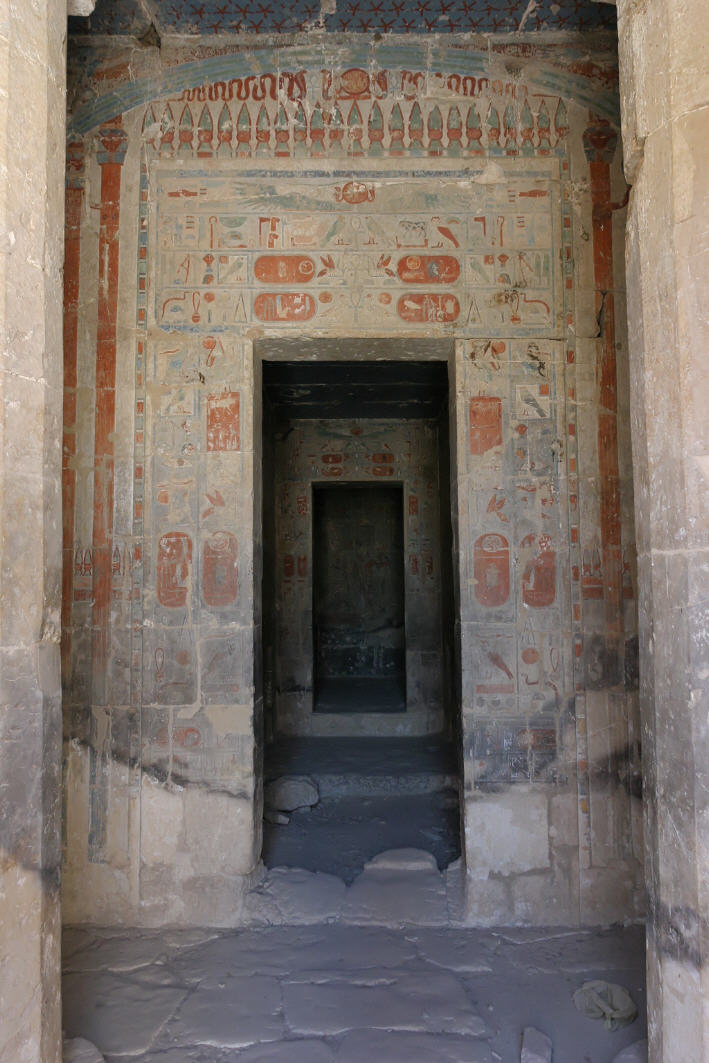
| The photo above shows the first door and the behind parts of the chapel
which has been restored during the last years. The photo below shows the
Hathor-heads of the two pillars depicted besides the royal titles on
lintel and jambs (position 7). |
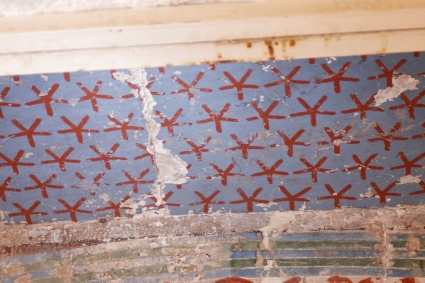
|
The ceiling of the antechamber as most like those of the passage and the
sanctuary as well was grounded with a blue color and decorated with red stars
which lead into the sanctuary. |
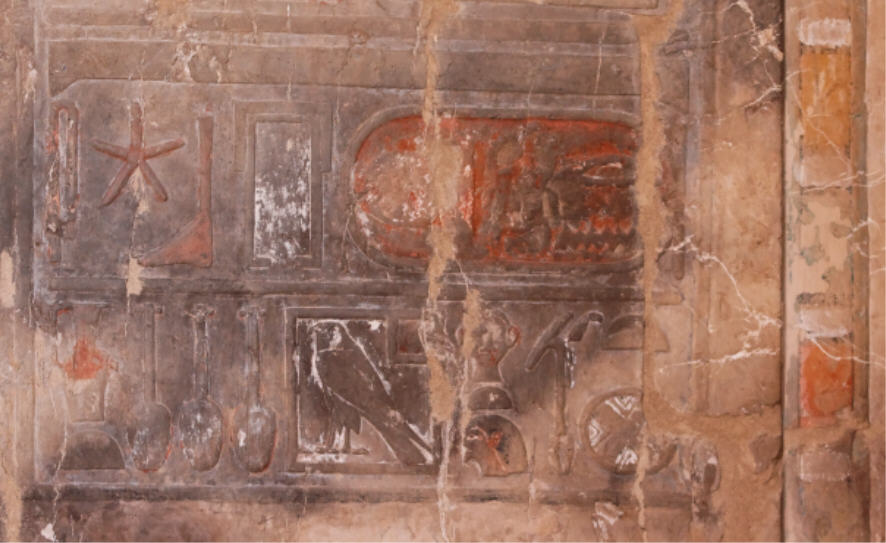
| The following two horizontal lines right (sie photo above) and left of the
doorway contain the name of the door "The door of Hatshepsut (i.e. Thutmosis
II) who has joined (with) the beauties of Hathor, chief of Thebes [= sbA
aA-xpr-n-Ra Xnmt nfrw @wt-@r hrt-tp
WAst]" (Grallert, 2001).
|
| The fact that a door-name is given here indicates that the following rooms had a different
cultic function and were therefore separated by a door from the antechamber with the two columns.
This is supported by a different decoration. All scenes of the antechamber show
the king performing several rites before different gods (e.g. Hathor,
Weret-Hekau, Amun). The scenes of the passage with niches and in the last room
do not show anymore an acting king. These scenes show acting gods for example
the Hathor-cow protecting and suckling the royal child or Hathor presenting the
king to Amun. |
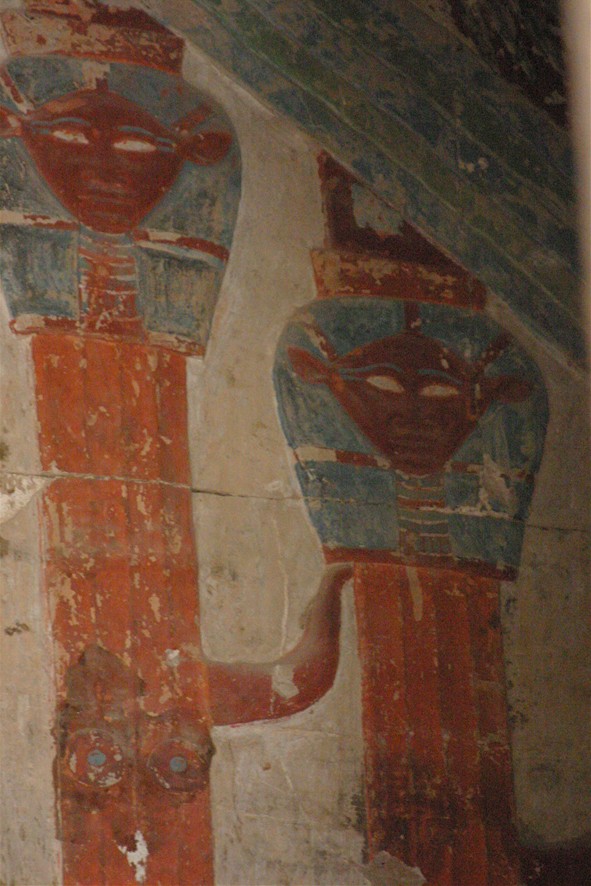
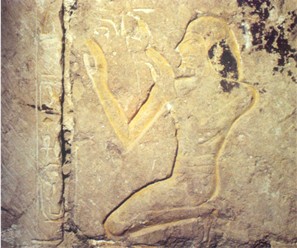
| Only here in the Chapel of Hathor, on the side wall of the niches
(position 8 and opposite niche), four reliefs showing the kneeling and praying Senenmut
have survived (photo by author, 2009). Inside a niche of the Upper Chapel of
Anubis a preliminary drawing of the same scene has survived - perhaps a sketch
for a relief that could not be finished. |
| The west wall of the sanctuary is quite good visible from the
entrance to the speos. Under a vaulted roof Hatshepsut, with double crown, is
shown standing between Amun (left) and Hathor (right). The winged sun disk, the
great God [of] Behedet, is depicted of the scene. |
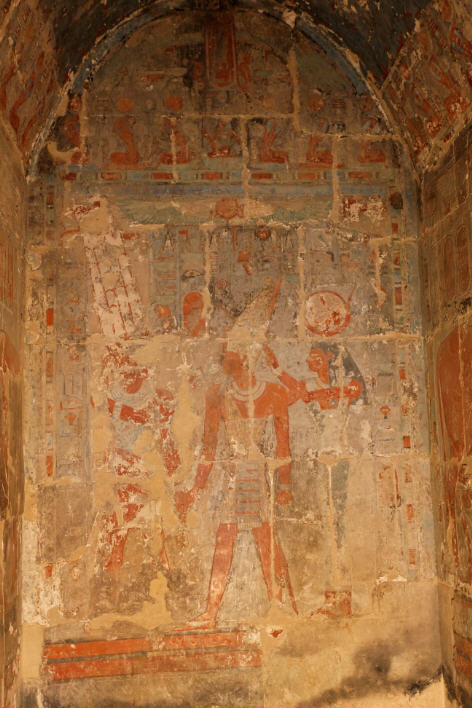
|
At position 9, at the far end of the chapel, the relief shows Hathor who
embraces the queen and leads her to Amun. |
|











